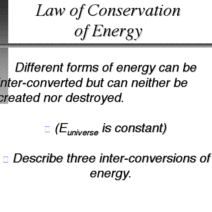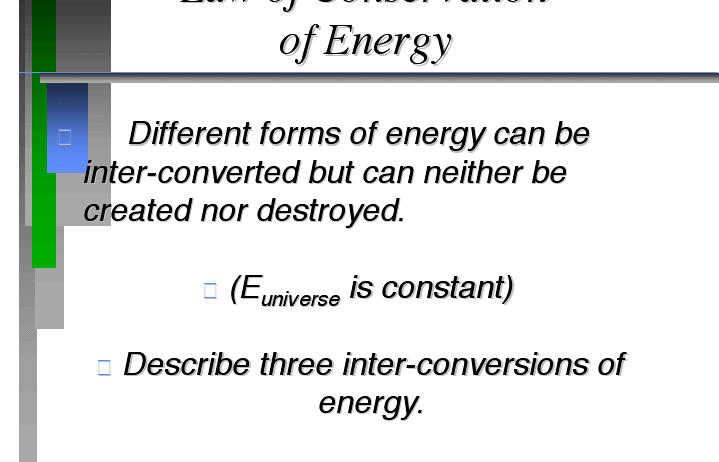The Law of Conservation of Energy is a fundamental concept in physics that is often articulated as “energy cannot be created or destroyed; it can only be transformed from one form to another.” While this might seem abstract, the implications of this law are profound, affecting various facets of our daily lives—from the way we utilize energy in our homes to the strategies employed in addressing environmental concerns.
This principle asserts that the total amount of energy in an isolated system remains constant. Consequently, energy may oscillate between different forms, but the total energy quantity remains unaltered. Understanding this principle is crucial as it lays the groundwork for disciplines such as thermodynamics and mechanical systems.
To delve deeper, let’s explore the different forms of energy and how they transform in practical scenarios. Energy exists in numerous forms, including kinetic energy, potential energy, thermal energy, chemical energy, and electrical energy. Potential energy, for instance, resides in objects due to their position or state—such as water stored in a dam. In contrast, kinetic energy is the energy of motion; as water is released from the dam, its potential energy converts into kinetic energy as it cascades downstream, driving turbines to generate electricity.
One of the most tangible examples of the conservation of energy is seen in the case of pendulums. When a pendulum swings, it showcases the conversion between kinetic and potential energy. At the apex of its swing, all energy is potential; as it moves downward, that potential energy translates into kinetic energy. When it reaches the lowest point, the kinetic energy maximizes before transitioning back to potential energy on the upward swing. This continuous cycle demonstrates energy transformation while illustrating that the overall energy remains constant.
In the realm of electricity generation, the law plays a critical role. For instance, the transformation of chemical energy in fossil fuels into electrical energy in power plants epitomizes the principle of energy conservation. Here, chemical reactions release energy that is harnessed to create steam, which in turn spins turbines. In this process, no energy is lost; rather, it changes forms, demonstrating that the conservation law is at play even on an industrial scale.
However, the transformation of energy is not always efficient. Energy losses often occur in the form of heat during these conversions. The efficiency of energy transformation is a critical metric in evaluating the effectiveness of energy systems. For instance, while combustion engines have improved in efficiency over the decades, they still waste a significant portion of energy—primarily as thermal energy, which escapes through exhaust systems. Renewable energy sources, such as solar and wind, aim to mitigate some of these inefficiencies, harnessing energy directly from natural processes and minimizing losses.
Moreover, the conservation of energy is inherently linked to environmental sustainability. As the global impetus shifts towards greener technologies, understanding energy transformation becomes vital. In solar panels, for example, sunlight is transformed into electrical energy without depleting the resources from which it is generated. This sustainable practice aligns with the conservation law, encapsulating the principle that energy can transition between forms, albeit while respecting ecological boundaries.
When examining everyday occurrences, the conservation of energy principle is omnipresent. Consider a vehicle in motion; it consumes chemical energy from fuel to produce kinetic energy for movement. The energy expended during acceleration might appear as if it vanishes, yet it is redirected—efforts expended result in heat dissipation and sound energy. This perception underscores that while energy can appear to diminish in one aspect, it often reallocates to different forms, just as highlighted by the conservation law.
The notion of energy efficiency is closely tied to conservation. Since energy cannot be created or eliminated, optimizing its usage is paramount. From weatherproofing our homes to using energy-efficient appliances, the goal remains to diminish unnecessary energy transformations and thus lower our overall footprint. Energy conservation in domestic settings not only preserves resources but also translates to economic savings, proving that sustainability can align with practicality.
Furthermore, the law of conservation of energy can also clarify energy consumption behaviors. By acknowledging that our habitual practices—such as leaving appliances on unnecessarily—are wasteful energy transformations, we become more mindful of our energy usage patterns. Awareness can lead to the adoption of better practices and encourage a culture that prioritizes energy conservation. For instance, turning off lights when not in use is a simple yet effective way to prevent unnecessary energy transformation into heat without losing the potential for lighting in the future.
In summary, the Law of Conservation of Energy is not merely an abstract concept confined to textbooks; it is a guiding principle that intricately weaves through the fabric of our physical world. From understanding energy in motion to the implications of our consumption patterns, the law has far-reaching consequences. Recognizing the importance of energy transformation offers valuable insights into designing sustainable systems, enhancing efficiency, and promoting environmental mindfulness. By embracing this principle, we take one significant step toward a more sustainable future.




